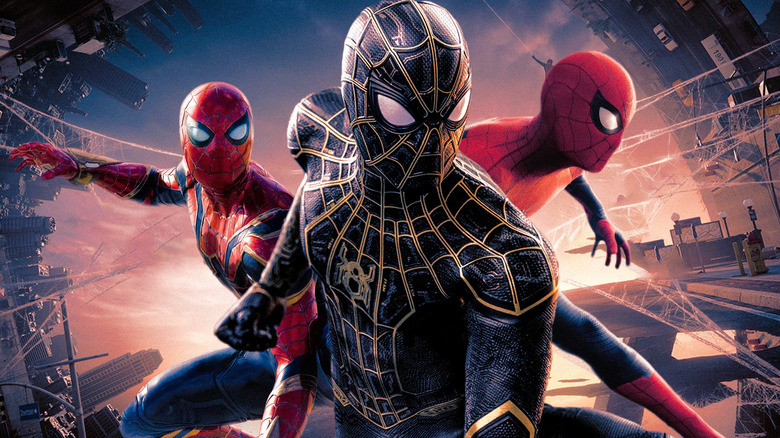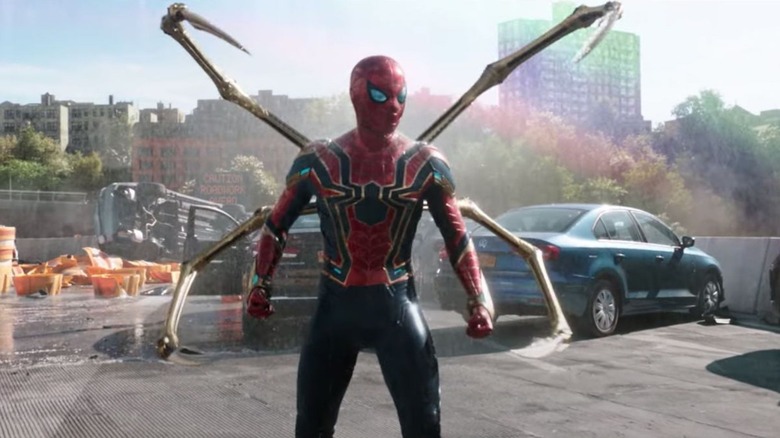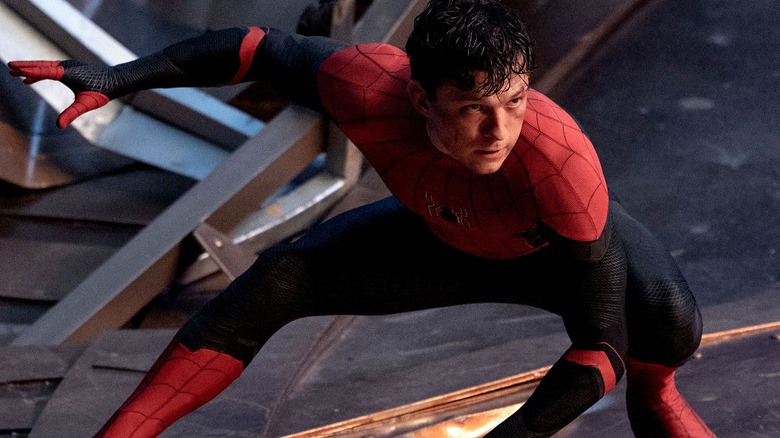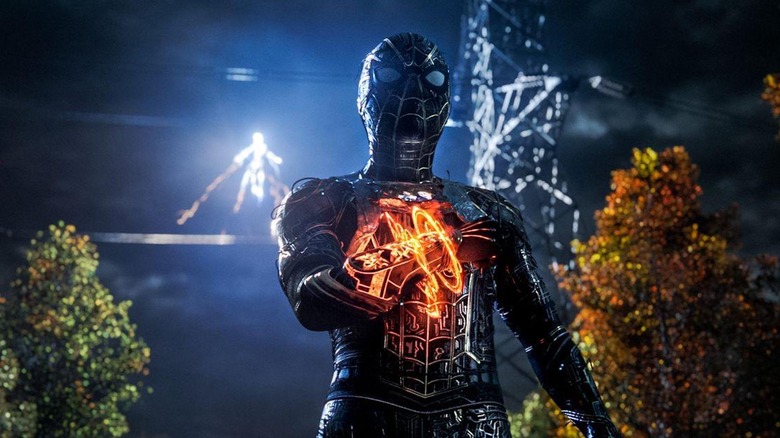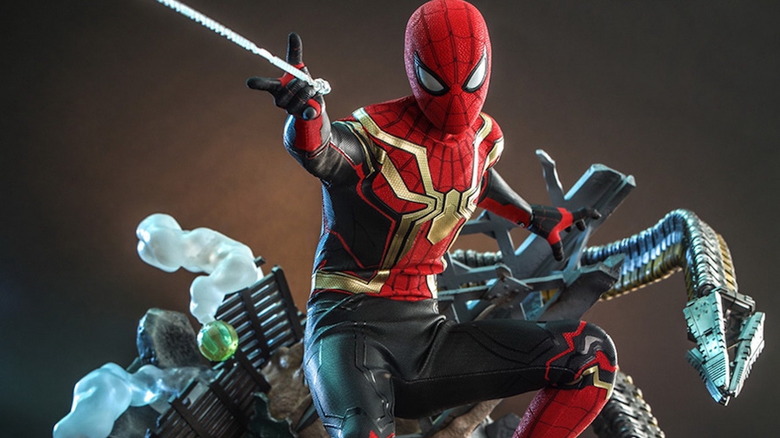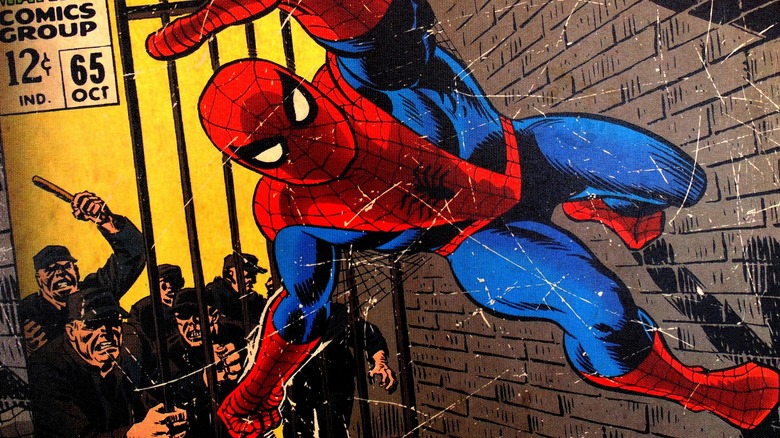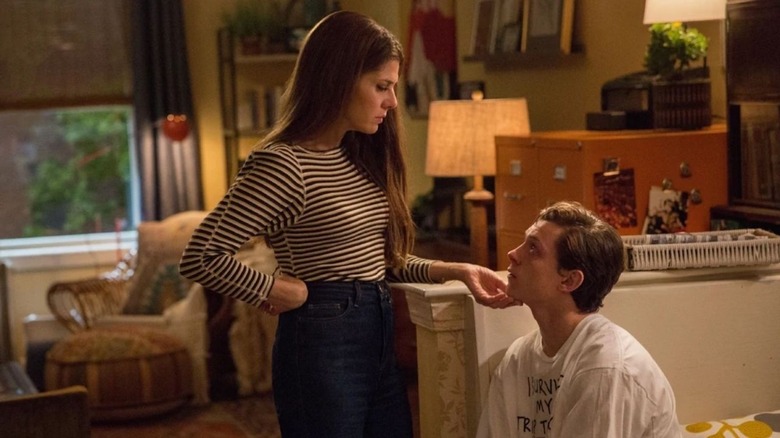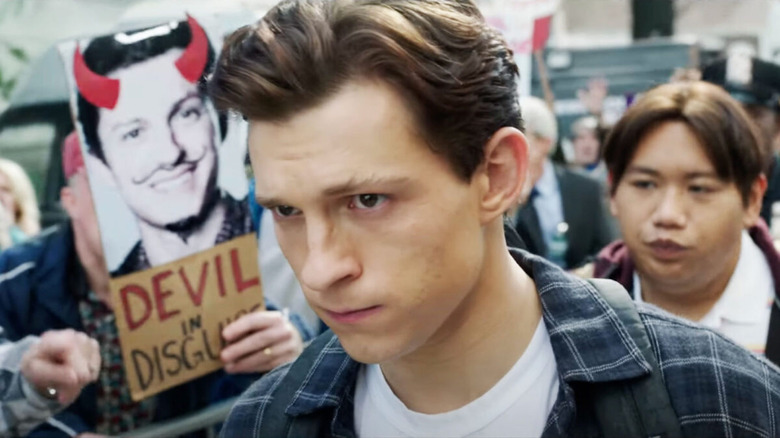What You Should Know About Each Suit In Spider-Man: No Way Home
Like millions of other geeks, I snagged tickets for "Spider-Man: No Way Home" for the earliest possible showing I could. It was clear that there was going to be a lot to talk about and not everybody has the good sense to talk about these things in articles clearly labeled as spoiler-heavy.
This article is full of spoilers, by the way. Like, last seconds of the movie kind of spoilers, so please for the love of all that is holy don't read any further unless you've either seen the movie or don't care at all about spoilers.
We could talk about the broader implications of the multiverse on the Marvel Cinematic Universe, or how they handled all those special cameos, but that's not what I walked away from the movie wanting to discuss. How about we focus this little palaver into something seemingly more simple?
I want to talk about the suits.
The Suits Embody Peter's Character Development
There's a million reasons for the people making "Spider-Man" movies to give us a variety of suits. Most of them are outside the creative realm, meant solely to sell action figures, Hot Toys, tee-shirts and the like. That comes with the territory when you're making these giant superhero movies.
That isn't to say that all costume changes are cash-grabs, however. Smart filmmakers know this is expected of them and roll that into the story. A good past example is the look of Tony Stark's suits in the first "Iron Man," as he goes from big and bulky suit made out of scrap parts, to a more polished prototype, and finally to the iconic Iron Man look.
What the filmmakers behind "Spider-Man: No Way Home" have done with Peter Parker's supersuits here is probably the best use of ol' web-head's threads in recent memory, although I will say that Jon Watts's films have been very good about making Spider-Man's outfits part of his emotional journey — especially because, up to this point, they've been tied to his relationship with Tony Stark.
"No Way Home" has a variety of looks to talk about. I'm just focusing on the Tom Holland Peter Parker here, but by my count we get four suits. You have the red/black Spidey suit he made at the end of the last movie, "Far From Home," the Iron Spider/Nanobot from "Avengers: Infinity War" and "Endgame," the black/gold suit he uses when confronting Electro for the first time, and then the more traditional Spider-Man red and blue glimpsed at the end of "No Way Home."
The Red and Black Suit
The traditional red and black suit gets the most play here and if I'm going to be honest, I still don't have a clear picture on whether or not the Iron Spider suit works in tandem with his usual red and black suit or if the nanobots are just kinda hanging out waiting to be used. For the sake of argument I'm counting them as two different suits.
We start with red and black because this movie picks up exactly where the post-credits scene from the last one ended. This suit represents Parker mixing the gifts of Tony Stark's tech with his own input. The Iron Spider suit is 100% Tony, built to protect this adopted son first and foremost. It's powerful, with an emphasis on force. Sometimes lethal force. You sense the arms manufacturer that was still deep inside Tony Stark in this suit.
The red and black suit was created by Peter while en route to fight Mysterio and save his friends in the last movie and is more in line with Parker's own thoughts on what Spider-Man should represent. It's a friendlier, less menacing look, but still has a lot of the Stark tech bells and whistles.
Now, the red and black suit and the black and gold suit are actually the exact same outfit. This is something I noticed a surprising amount of people at last night's screening seemed to miss, judging by some overheard conversation as I was leaving the theater.
The Black and Gold Suit
The red and black suit is compromised when Spidey gets doused with green paint by a Mysterio fan and he can't get the stain out on his own. He needs Aunt May's help for that, so when pressed into action on short notice he turns his red and black suit inside out — which explains why you see a lot of the suit's underlying tech on the surface.
On a character level, you could read this as Spider-Man's world having been turned inside out. Parker's world is blowing up. His identity has been revealed, his tight circle of friends is threatening to break apart as their high school experience comes to an end, and now this spell is going wrong just as he's on the verge of fixing his reputation.
It's a dark time for Peter Parker where what used to be up is down and what was light is now dark. The inside-out suit is a perfect representation of this.
It might be a stretch, but one could also read it as foreshadowing the pending temptation to a darker side for Mr. Parker. That might not be the primary decision for going with this particular look, but it was certainly on the filmmakers' minds. I mean, what piece of the exploded Lego Death Star does Peter keep? The Emperor, who is the very embodiment of the temptation to give into anger and hate and revenge.
The Iron Spider Suit (With Fancy New Gold Emblem)
This is the suit Spidey is wearing with his confrontation with Doc Ock. The nanobots from this suit not only protect Parker from the killing blow Ock sends his way, they also graft onto Ock's mechanical arms, infiltrating the tech and giving Parker full control over them, essentially making Octavius a prisoner of his own technology.
There's an interesting mirror here: The Iron Spider suit has mechanical arms, and so does his opponent. Alfred Molina even has a line acknowledging this, when he tells his own mechanical arms they have some competition. It's interesting that the villain Peter Parker can relate to the most is mirrored in this way. Also, let's not forget Otto Octavius isn't a monster — it's his tech that went haywire and took over. And why is Parker in trouble in this movie? Because he lost control of his tech in "Far From Home."
The Iron Spider Suit gets a cosmetic upgrade towards the end of "Spider-Man: No Way Home" in the form of a shiny gold spider emblem, courtesy of Doctor Octopus. After Peter cures the good doctor and is sure he's no longer a threat, he is given his nanobots back by Doc Ock. When the nanobots transferred to Ock's arms, they took the form of red plating. When Spider-Man gets them back, it seems like Ock is giving a little of himself as well. The emblem, once a gold outline filled with blue, is now a solid gold color.
I read this as a little reward — a gold star, if you will — for Peter making the right decision and helping Otto instead of dooming him to death. A good deed pushes Peter slightly closer to the light. It reflects the optimism of the moment. He is so close to fixing everything! Of course, it all comes crashing down moments later.
The Classic Red and Blue Suit
Now we get to the most interesting suit featured in "Spider-Man: No Way Home." We've seen each and every other suit before (even the black and gold is a previous outfit, just inside out), but in the final seconds of the movie we get the traditional bright red and blue Spider-Man suit from the comics and the emotional weight of this outfit is twofold.
One, it's just soaring nostalgia for geeks like me who grew up reading "Spider-Man" comics. The webslinger was my gateway into comic books as a kid and seeing, even briefly, the classic simple suit thwiping away into the night sent my heart soaring.
And then I was hit by something as I put some pieces together in my head. This suit means more than just a nod to the comic book. It represents something far deeper.
I was serious about spoiler warnings before, but I'm doubly serious now. This is real spoiler territory so enter at your own discretion.
With Great Power Comes Great Responsibility
Parker's life changes drastically in "Spider-Man: No Way Home," but the most devastating turn is the death of Aunt May. This hurts Peter in a way that nothing else could and sends him dangerously close to turning into a villain himself. Well, maybe not a villain, but at the very least the violent vigilante that J. Jonah Jameson has accused him of being for the whole movie.
At the end of the film, Peter embraces May's final words to him: the iconic "with great power comes great responsibility" line that defines Spider-Man as a character. He chooses good, sacrificing literally everything he holds dear to make things right.
The MCU version of Peter Parker has always been a pure character, all optimism and good cheer and empathy. But he's never had to make a choice like this. The only way to fix the world is for the world to forget Peter Parker ever existed. For the good of the many, Parker loses his true love, his best friend, and any power he ever wielded as an Avenger and quasi-heir to Tony Stark's tech and unlimited cash. He resets the game board, stripped of everything he has fought for and earned, leaving nothing but Peter Parker, studying for his GED and living on his own without any friends, family, or support of any kind.
In essence, "Spider-Man: No Way Home" ends with the Peter Parker that we know and love from the comics. He's the guy who can barely make rent and has to get by on his smarts, not the one that has the Avengers on speed dial. So when that red and blue suit comes out, it represents the more traditional Spider-Man that the world has loved for nearly 60 years.
That's the outside emotional read, but there's an even more powerful one from the MCU movies themselves — and this is another thing a lot of people have missed.
Moving Forward With Love
Tom Holland's Peter Parker makes the final suit himself, using Aunt May's sewing machine and fabric. We see her sewing earlier in the movie, helping to fix up Norman Osborn's clothes, I believe. After her death we get a shot of her sewing machine, standing still, a garment half-finished in the teeth of the machine.
All of his previous suits represented Tony Stark's love for him. This new one represents Aunt May's love.
There is no fancy tech, no billion dollar AI assistant. It's just Peter Parker using Aunt May's sewing machine and fabric to construct a simple suit that he'll use to continue being the person she wished he would be: a selfless, kind, and compassionate person who uses his powers to help people.
It's easy to be cynical with these giant tentpoles made by mega-rich corporations, but the suits in this movie track the emotional journey of one of the most likable fictional characters ever created. Every single one has a deeper meaning and is connected to Peter Parker's journey in some way, not there just to move a few extra action figures.
The red and blue suit signals a transition to adulthood. He's had his heart broken. He's made mistakes. He's all alone and heading out into a big, scary world with absolutely no support. But while he might be stripped down to the basics, the bright red and blue tells us Spider-Man is still out there, fighting for us. And as he embodies his aunt's dying wish, he's doing so flying her colors.
